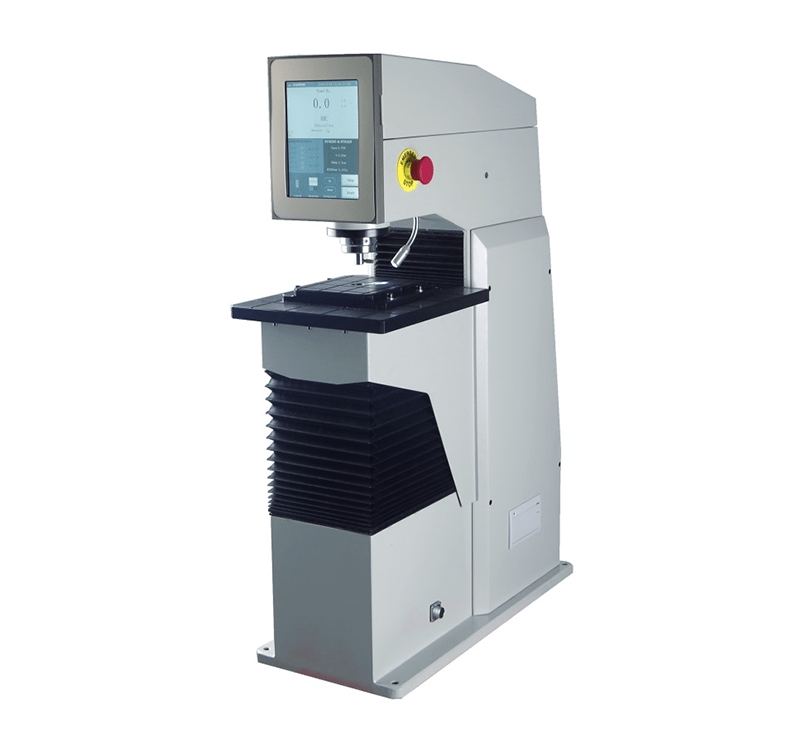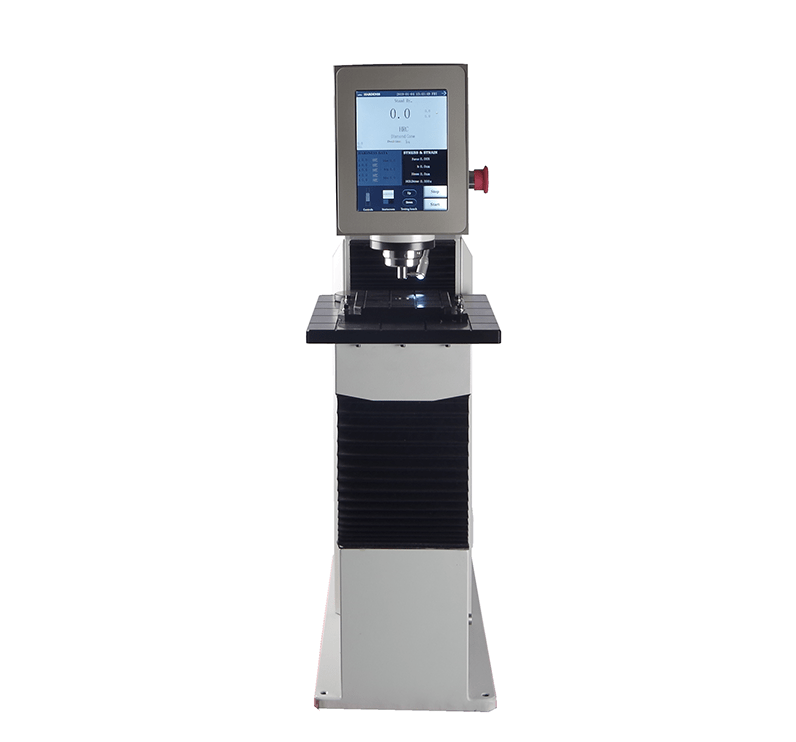MHRS-150/45-Z Full Automatic Double Rockwell Indenter
The Full automatic Double Rockwell hardness tester adopts the advanced closed-loop sensor control technology in the world to realize the automatic control and hardness testing process. The loading system uses a high precision force sensor and a central controller to form a closed loop to track and control the whole microsecond loading process.
High precision displacement sensor is used in Bathymetric system, and the resolution of minimum hardness is 0.1HR. The position of indenter is fixed and the hardness is tested by moving the platform up and down. The overall movement of the large platform eliminates the gap caused by the lifting of the screw, greatly improves the accuracy and repeatability of the test, and also increases the stability and efficiency of the machine. New foot switch function, one-button measurement, save a lot of manpower, convenient for field use.
Characteristics of MHRS-150/45-Z Rockwell Indenter
- The high precision loading system can effectively avoid the overload of force measurement and greatly improve the loading speed.
- It can realize remote control.
- The frame structure is strong and rigid.
- Loading with fully automatic closed-loop sensor, the accuracy of the test force is as high as 23g.
- 15 Rockwell hardness gauges can be tested.
- High precision, international contrast, single point measurement only needs 13s;
- The resolution of displacement sensor is 0.1HR.
- The repeatability accuracy of hardness is 0.5HR.
- High-speed step control, very fast test speed (1.75s);
- Easy to operate, Chinese-English interface can be switched (other language versions can be customized)
- It is easy to install and debug without installing weights.
- The unique pedal switch design, the automatic lifting of the working platform as a whole and the initial test force of the automatic load can ensure the stable generation of the force measurement.
- Save manpower, one-button automatic measurement;
- High precision, international contrast, single point measurement only needs 13s;
- The curve display of the testing process can visually display the material characteristics, and facilitate observation and learning.
- Continuous measurements can be made in and out of the fixed worktable through the automatic withdrawal function of the indenter.
- High definition LCD, touch screen operation, menu operation interface;
- Automatic loading and unloading, adjustable holding time;
- GO/NG tolerance judgment;
- Correction of test values of cylinder and sphere;
- Force selection and hardness scale selection are linked.
- Scale conversion HR, HB, HV;
- Built-in printer;
Upgrade Details of MHRS-150/45-Z Rockwell Indenter
- Fully automatic high-speed response closed-loop sensor loading system, moving the platform as a whole, realizing high-precision and fast testing to improve the control accuracy of the actuator
- The original system belongs to the millisecond control system and can not realize step control.
- The new system belongs to a microsecond control system and can realize high-speed step control.
The accuracy of step control can reach nanometer level!
1. Improve the comprehensive performance of equipment, improve the detection accuracy and speed of equipment
- Enhance the ability to process analog signals of force sensors. Change eyes
- Enhance the ability to process the whole digital signal. Changing core
- Improve the accuracy of displacement measurement. Changing ears
- Improve the accuracy of motor control. Change hands
- Improve the man-machine interface. Change face
2. Setting up special management device QEI for displacement sensor
The original motherboard has no special management device. CPU must process displacement sensor signals in person throughout the loading process.
After setting up the special management device, the CPU only needs to read the data at the beginning and the end of the two time points. During the loading process, the CPU can centralize resource management sensors and load motors, which makes the control faster and more accurate.
3. Importing Japan High Precision Magnetic Grating Displacement Sensor
The in-situ displacement sensor is a grating displacement sensor made in China. There is a problem of poor consistency, which needs to be matched with equipment selection.
Japanese high precision displacement sensors have high consistency. It is less affected by the environment.
4. Life expectancy can reach more than 150 million times.
The loading process of the traditional electric Charlotte hardness tester is slow. If the loading speed is controlled within 8 seconds required by the national standard GBT230/T-91, the red curve in the figure will continue to overshoot and unload in the total test force F to approach the total F. The results are as follows: firstly, the hardness tester must slow down the speed of the test, which results in the detection time being too long; secondly, the phenomenon of overshoot affects the accuracy of the test to a certain extent.
This equipment adopts more advanced and applicable central processing chip, which responds to the whole hardness test process at high speed. From the start to the end of each hardness test, the central processing chip will process 18,000-30,000 sets of data at super high speed. It takes 8 seconds for the traditional electric loading hardness tester to perform the loading action, which is shortened to 1.75 seconds (ISO6508-1:99 unifies the test force application time within 1-8 seconds). As shown in the blue curve in the figure, the speed of loading process reaches extreme speed, and the force value is smooth and no overshoot during loading to the total test force, which improves the loading speed and accuracy of the charged hardness tester.
X-4.jpg)
X-5.jpg)
Detailed Explanation of Curves
1. Force Value and Depth Curve
During the working process of the hardness tester, the main chip reads the data of pressure sensor and displacement sensor in real time, and converts the data into curves. The curve in the graph is the force and depth curves of 28.3 HRC hardness block.
2. Pressure-Depth Curve
Synchronized data of pressure and depth are derived in the process of testing, pressure-depth curve is automatically generated, and shadow area is obtained for elastic modulus research. The vertical coordinate is pressure and the abscissa is depth.
X-6.png)
Accurate hardness correction
For example, the standard hardness curve is a straight line, as shown in the black section.
The hardness of the traditional electric digital hardness tester can be automatically corrected as the yellow line in the figure. The hardness correction is generally divided into three sections, and the hardness is basically consistent with the standard hardness only near the calibration point. The farther away from the calibration point, the greater the difference of the hardness value.
X-7.png)
The original hardness curve of the machine is shown in the red section of the figure after further modification and upgrading of the control method of “Aolongxin”. When the hardness of the whole range is corrected to a common coefficient, the hardness curve will be raised to the state that the standard hardness curve coincides with the hardness curve. It is concluded that the hardness of the standard hardness blocks of HRC24, HRC48 and HRC63 is tested without any interval correction after a common coefficient is given. The hardness errors of the standard hardness blocks are 0.9 HRC onHRC24, 0.2 HRC on HRC48, and0.8HRC on HRC63, respectively, and the hardness errors of the standard hardness blocks are 0.9 HRC, 48HRC and 63HRC respectively. The difference is 0.8 HRC.
Now the whole hardness interval is divided into more than eight hardness correction intervals, as shown in the blue line section. This correction method refines the whole hardness interval and simplifies and precisely the hardness correction of the electric digital hardness tester.
Technical Parameters of MHRS-150/45-Z Rockwell Indenter
| Model | MHRS-150/45-Z |
| Initial test force | 3kgf、10kgf |
| 29.4N、98N | |
| Main test force | 15kgf、30kgf、45kgf、60kgf、100kgf、150kgf |
| 147.1N、294.2N、441.3N、588.4N、980.7N、1471N | |
| Rockwell Scale | HRA、HRB、HRC、HRD、HRE、HRF、HRG、HRH、HRK、HRL、HRM、HRP、HRR、HRS、HRV、 HR15N、HR30N、HR45N、HR15T、HR30T、HR45T、HR15W、HR30W、HR45W、HR15X、HR30X、HR45X、HR15Y、HR30Y、HR45Y |
| Testing range | HR15N:70-94、HR30N:42-86、HR45N:20-77、HR15T:67-93、HR30T:29-82、HR45T:10-72 |
| Specification of indenter | Diamond Rockwell indenter,Φ1.5875mm steel ball indenter |
| Executive standard | ISO 6508,GB/T230,JJG112,ASTM E18 |
| Scale conversion | HR、HB、HV、HK |
| Indication of Hardness Value | LCD Digital Display |
| Date output | Built-in printer RS-232 interface |
| Maximum height of specimen | 170mm |
| Distance from the center of the indenter to the body | 155mm |
| Power supply | AC90-240V 50-60Hz |
| Shape size | 590*260*890mm |
| Machine net weight | About 120kg |
Standard Configuration of MHRS-150/45-Z Rockwell Indenter
| No | Name | Quantity |
| 1 | Diamond Rockwell indenter | 1 |
| 2 | Ø1.5875mm Steel ball indenter | 1 |
| 3 | medium and V-shaped test-bed | 2 |
| 4 | Rockwell standard block | 6 |
| 5 | Fuse 0.5A | 2 |
| 6 | Power cord | 1 |
| 7 | Manual | 1 |
| 8 | Product Qualification Certificate | 1 |
| 9 | Thermosensitive printing paper | 1 |



